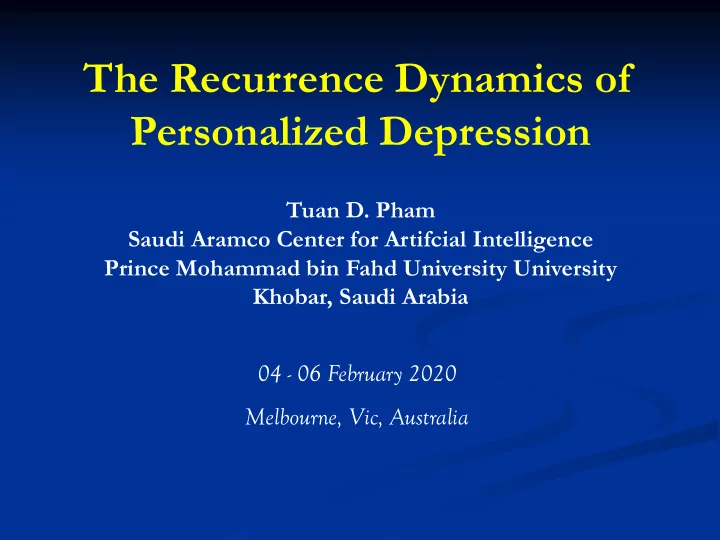

The Recurrence Dynamics of Personalized Depression Tuan D. Pham Saudi Aramco Center for Artifcial Intelligence Prince Mohammad bin Fahd University University Khobar, Saudi Arabia 04 - 06 February 2020 Melbourne, Vic, Australia
Outline ◼ Depression and Nonlinear Dynamics ◼ Data of Personalized Depression ◼ Analysis of Depression with Nonlinear Dynamics ◼ Results & Discussion ◼ Conclusion
Depression and Nonlinear Dynamics ◼ Major depression (MD) is associated with morbidity and risk for suicide. ◼ Response rates of antidepressant treatments are relatively low. ◼ In addition to the heterogeneous causes of MD, the disorder shows complex transitions between several disease states. ◼ Hypotheses trying to explain the dynamics of depression have certain limitations, so our understanding what causes depression is still incomplete ( Demic & Cheng, PloS One, 2014 ).
Data of Personalized Depression ◼ The participant completed 1478 measurements over the course of 239 consecutive days in 2012 and 2013. ◼ Five phases: 1 (base line), 2 (double-blind, no antidepressant reduction), 3 (double- blind, under antidepressant reduction), 4 (post assessment), and 5 (follow-up).
Data of Personalized Depression ◼ Twelve affective items: 1) restless, 2) agitated, 3) irritated, 4) anxious, 5) lonely, 6) guilty, 7) enthusiastic, 8) cheerful, 9) content, 10) strong, 11) worrying, and 12) suspicious. ◼ The five mental states: 1) unrest, 2) negative, 3) positive, 4) worrying, and 5) suspicious. ◼ Measurement: 7-point Likert scale: -3 (not) to 3 (very), or 1 (not) to 7 (very).
Analysis of Depression with Nonlinear Dynamics ◼ Fuzzy recurrence plots ◼ Fuzzy joint recurrence plots ◼ Fuzzy weighted recurrence networks ◼ Tensor decomposition of mental-state dynamics
Recurrence Plots A recurrence plot (RP) enables us to investigate certain aspects of the m -dimensional phase space trajectory through a 2-D representation.
What can an RP tell? ◼ An RP is characterized by typical patterns, helpful for understanding the underlying dynamics of the system investigated. ◼ A homogeneous distribution of points: associated with stationary stochastic processes; e.g., Gaussian white noise. ◼ Long diagonal lines: periodic behaviors ◼ White areas or bands: non-stationarity and abrupt changes in the dynamics.
(a) (b) (a) RP of a logistic map that consists of single dots and line structures (Marwan et al., Physics Letters A 360 (2007) 545 – 551. (b) RPs for a sinusoidal signal: 2 Hz (left) and 25 Hz (right) (Llop et al, Int. J. Multiphase Flow , 73 (2015) 43-56.
RPs vs. FRPs ◼ RPs are displays of binary texture. ◼ FRPs are displays of gray-scale texture. ◼ RPs are sensitive to the threshold for similarity. ◼ FRPs are visible with selection of various numbers of fuzzy clusters.
Fuzzy Relation where θ and ψ are cluster centers, and x is a data point. The use inference of relation between cluster centers allow scalability of the network.
EMG signals: healthy (left), myopathy (center), and neuropathy (right). Hierarchical clustering of characteristic path lengths (PN: pink noise, WN: white noise).
Published January 2020
Tensor Decomposition Subjects x Mental States x Recurrence Dynamics
Results & Discussion
Results & Discussion
Results & Discussion Fuzzy joint recurrence plot of time series of the unrest state (e) in experimental phase 1 (baseline).
Results & Discussion
Results & Discussion
Results & Discussion
Results & Discussion
Results & Discussion
Results & Discussion
Results & Discussion
Conclusion ◼ Both complex network analysis and tensor-decomposition of the recurrence dynamics indicate that the participant was vulnerable to develop a new episode of depression when the anti-depressant medication was reduced and stopped. ◼ Such a detection in the recurrence dynamics of the data van be considered as a personalized warning signal for depression.
Thank you for your attention. Questions?
Recommend
More recommend